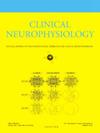EEG is better when cleaning effectively targets artifacts
IF 3.6
3区 医学
Q1 CLINICAL NEUROLOGY
引用次数: 0
Abstract
Objective
Electroencephalography (EEG) data are contaminated by a range of non-neural artifacts. The confounding influence of artifacts is often addressed by using independent component analysis (ICA) to decompose data into components, subtracting artifactual components, then reconstructing data into the electrode space. Due to imperfect component separation, this common approach can remove neural signals as well as artifacts. Here, we demonstrate the counterintuitive finding that this can artificially inflate event-related potential and connectivity effect sizes and bias source localisation estimates, while also removing neural signals.
Methods
We developed a novel method that targets cleaning to artifact periods of eye movement components and artifact frequencies of muscle components, and tested our method across different EEG systems and cognitive tasks.
Results
Our targeted artifact reduction method was effective in cleaning artifacts while also reducing the artificial inflation of effect sizes and minimizing source localisation biases.
Conclusions
EEG pre-processing of Go/No-go and N400 task data is better when targeted cleaning is applied, which better preserves neural signals and mitigates effect size inflation and source localisation biases that result from subtracting artifact components.
Significance
These improvements enhance the reliability and validity of EEG analyses. Our method is provided in the RELAX pipeline, which is freely available as an EEGLAB plugin (https://github.com/NeilwBailey/RELAX).
当清洗有效地针对伪影时,EEG效果更好。
目的:脑电图(EEG)数据受到一系列非神经伪影的污染。伪影的混淆影响通常通过使用独立成分分析(ICA)来解决,将数据分解成组件,减去伪影组件,然后将数据重建到电极空间。由于分量分离不完善,这种常见的方法既可以去除神经信号,也可以去除伪影。在这里,我们证明了反直觉的发现,这可以人为地夸大事件相关的电位和连接效应大小以及偏差源定位估计,同时也消除了神经信号。方法:我们开发了一种针对眼动成分伪影周期和肌肉成分伪影频率的新方法,并在不同的EEG系统和认知任务中测试了我们的方法。结果:我们的目标伪影减少方法在清理伪影方面是有效的,同时也减少了效应大小的人为膨胀和最小化源定位偏差。结论:当应用目标清洗时,Go/No-go和N400任务数据的EEG预处理效果更好,这可以更好地保留神经信号,减轻由于减去伪影成分而导致的效应大小膨胀和源定位偏差。意义:这些改进提高了脑电图分析的信度和效度。我们的方法是在RELAX管道中提供的,它可以作为EEGLAB插件免费获得(https://github.com/NeilwBailey/RELAX)。
本文章由计算机程序翻译,如有差异,请以英文原文为准。
求助全文
约1分钟内获得全文
求助全文
来源期刊

Clinical Neurophysiology
医学-临床神经学
CiteScore
8.70
自引率
6.40%
发文量
932
审稿时长
59 days
期刊介绍:
As of January 1999, The journal Electroencephalography and Clinical Neurophysiology, and its two sections Electromyography and Motor Control and Evoked Potentials have amalgamated to become this journal - Clinical Neurophysiology.
Clinical Neurophysiology is the official journal of the International Federation of Clinical Neurophysiology, the Brazilian Society of Clinical Neurophysiology, the Czech Society of Clinical Neurophysiology, the Italian Clinical Neurophysiology Society and the International Society of Intraoperative Neurophysiology.The journal is dedicated to fostering research and disseminating information on all aspects of both normal and abnormal functioning of the nervous system. The key aim of the publication is to disseminate scholarly reports on the pathophysiology underlying diseases of the central and peripheral nervous system of human patients. Clinical trials that use neurophysiological measures to document change are encouraged, as are manuscripts reporting data on integrated neuroimaging of central nervous function including, but not limited to, functional MRI, MEG, EEG, PET and other neuroimaging modalities.
 求助内容:
求助内容: 应助结果提醒方式:
应助结果提醒方式:


